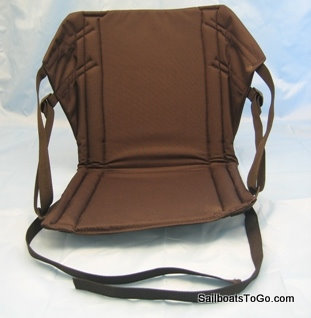Sailing Safety Tips from SailboatsToGo LLC
Every sailor of every boat has to evaluate conditions before setting off. Take into account weather, tides, currents, waves, visibility, forecasts, and boat traffic in evaluating whether conditions are appropriate for your boat and your skill level.
Bring life jackets, oars/paddles, a bailing bucket & a cellphone in a waterproof bag. Don�t sail farther from shore than you could row or paddle. Monitor changing weather conditions and head for shore if the trend is unfavorable. Learn and follow the rules of safe boating from an authoritative source like the Coast Guard.
Don't forget it takes MUCH longer to get to an upwind destination than a downwind destination. Also, strong currents could take you backwards even in a good wind.
On cold water especially, make sure there are other boaters around and you have a way to attract their attention for your immediate rescue if needed, because being in cold water kills rather fast. Learn anti-hypothermia survival techniques and safer ways to warm a hypothermia victim so you don't kill them (link) .
Our inflatable sailboats, canoes with outriggers fully extended and kayaks with outriggers fully extended are very stable, but no boat is capsize proof. If you're having trouble righting a capsized boat, tie a line to the far side, throw it over the upturned bottom amidships, brace elbows on the near side of the boat, and pull on the line. Resting your elbows on the upturned bottom will give you a good "up angle" on the line to lift that far side, and at the same time you can control the boat with your elbows and body so it doesn't turn away from you when you pull. If you need more oomph to pull the boat upright, climb up on it, hold that rope going to the other side, and fall backwards. If you can arrange to be on the upwind side of the boat when it comes back upright, that will be a big advantage for keeping it upright while climbing back in, because that will put the sail on the side opposite you, counterbalancing your weight. Capsize recovery video demonstration.

Practice recovering from a capsize under safe conditions.

A bailing bucket is essential once you have righted a capsized canoe or if your boat or canoe gets swamped. Keep one in the boat, secured with a line to the boat, so it doesn't get lost in an emergency. A lost bailing bucket can turn what would have been a simple dunking into a serious emergency, so remember to tie it to something. (See item 5109 below) Stabilizers won't necessarily keep you from taking water over the gunwale (edge of the canoe) in challenging conditions!
Always be ready to slacken the main sheet (rope that controls the sail) instantly in case a big gust comes along. Keep an eye out in the upwind direction so you can see big gusts and big waves before they hit (gusts show up as dark spots on the water).
When sailing a catamaran, know that as soon as you start lifting one pontoon off the water, you are entering a zone of much greater risk of capsize. People who want to minimize risk of capsizing a catamaran should keep both pontoons on the water, and you can do this by slacking off on the sheet to spill wind.
Check all equipment on or near shore for damage, proper setup, loose attachments. If you are going to sail a canoe or kayak, check: (1) leeboards set no more than 24 inches behind mast; (2) all gunwale clamps, nuts & bolts tight; (3) outrigger arms extended to maximum length, floats set up tight to arms; (4) canoe has sufficient flotation even when swamped (add sponsons, flotation bags, as needed).
Four safety websites:
http://homepages.rya-online.net/ocsguk/ocsg_safety.htm
http://www.hypothermia.org/inwater.htm
http://mariovittone.com/2010/05/154/ - Surprising information on recognizing drowning.
A very important safety product:
Waterproof, floating, cell phone or GPS case. $25 $5 shipping.
Cell Phone Case or GPS Case for Boating
Click: Buy Now To Purchase
Think of this cell phone case as a boat for your cellphone. The opaque part of the cell phone case is filled with soft flotation foam, like in a lifejacket. The water tight seal cell phone/ GPS case is formed by folding the top over at least 3 times and then buckling the buckle. A clip is provided for clipping the waterproof case to your clothing or onto the boat. It is totally practical to operate the cell phone or gps without removing it from the case. You can punch the buttons, read the display, talk and listen right through the case. There is a good chance you will ruin your cell phone or GPS if you take it boating without a good case. A zip lock bag from the kitchen will not do it! Then it won't work in an emergency and you will have to spend much more than $25 to replace it, and you'll still need to spend $25 to protect the new one after you have learned your lesson! So be smart: Get a waterproof case now before the water gets to your expensive, important electronic device. More Info
Another very important safety product: Canoe Outriggers

After safety, comes comfort. Get back support!
Comfy seat. Internal fiberglass rods for stiffness and support. 15 inches high. The best of this type of product. Add to your backless canoe seat. Secures with straps. $45
SailboatsToGo
 Cart
Cart